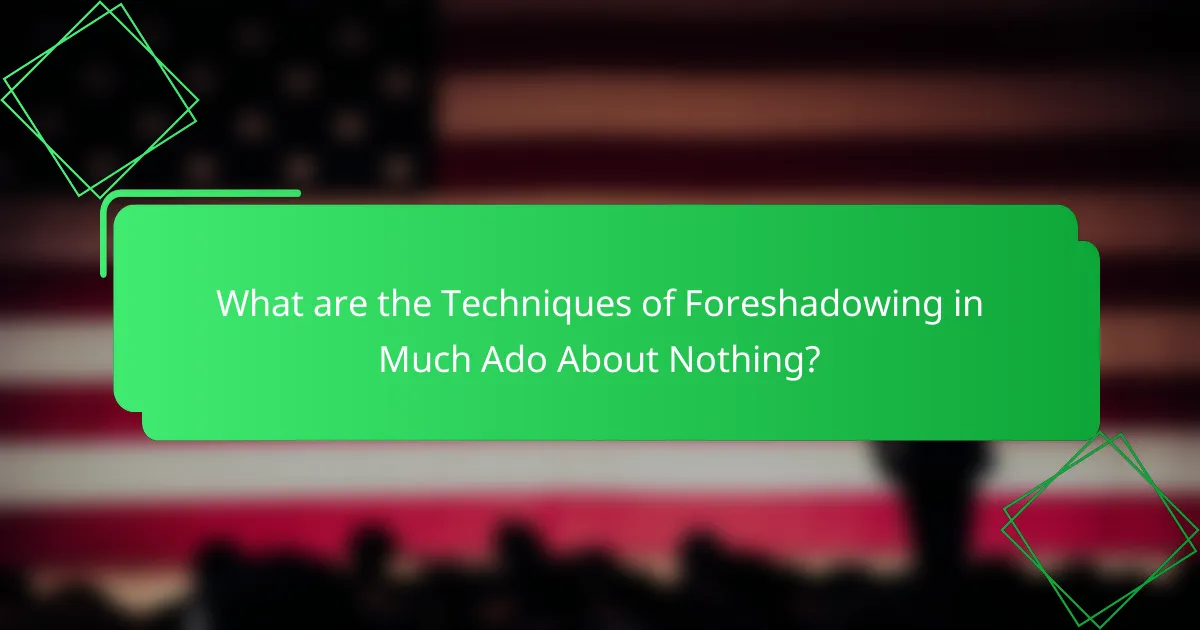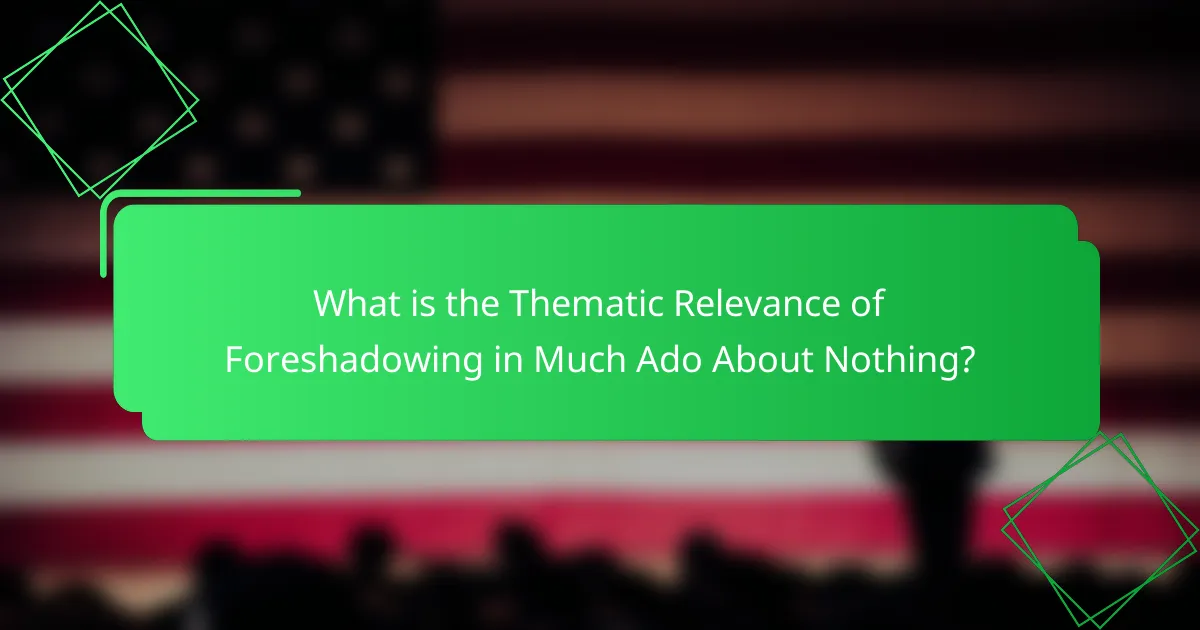
What is Foreshadowing in Much Ado About Nothing?
Foreshadowing in Much Ado About Nothing is a literary device that hints at future events. It creates suspense and prepares the audience for upcoming plot developments. For example, early conversations between characters often suggest later misunderstandings. The dialogue between Benedick and Beatrice sets the stage for their eventual romantic entanglement. Additionally, references to deception foreshadow the central conflicts of the play. This technique enhances the thematic relevance of love and trust. Overall, foreshadowing enriches the narrative by building anticipation and deepening character arcs.
How does foreshadowing function within the narrative?
Foreshadowing functions within the narrative by hinting at future events. It creates anticipation and builds tension in the audience. In “Much Ado About Nothing,” Shakespeare uses subtle clues to suggest upcoming conflicts. For instance, the mention of deception foreshadows the misunderstandings between characters. This technique enhances the emotional impact of the story. It allows viewers to engage more deeply with the plot. Foreshadowing also reinforces the themes of love and betrayal throughout the play. Overall, it serves as a critical device for narrative cohesion and audience engagement.
What are the key techniques of foreshadowing used in the play?
Key techniques of foreshadowing in the play include dramatic irony, symbolic imagery, and character dialogue. Dramatic irony occurs when the audience knows more than the characters, creating tension. For example, the audience is aware of Don John’s deceit while other characters are not. Symbolic imagery, such as the use of masks, hints at hidden truths and identities. Character dialogue often contains subtle hints about future events, like when characters express doubts or concerns. These techniques effectively build anticipation and enhance the thematic depth of the narrative.
How does foreshadowing enhance the plot development?
Foreshadowing enhances plot development by creating anticipation for future events. It subtly hints at what is to come, guiding the audience’s expectations. This technique builds tension and intrigue throughout the narrative. In “Much Ado About Nothing,” specific instances of foreshadowing, such as the discussions of honor and deception, set the stage for later conflicts. For example, early conversations about loyalty suggest impending betrayals. This prepares the audience for emotional and plot twists. The use of foreshadowing thus enriches the storytelling experience. It deepens character arcs and heightens the impact of resolutions.
Why is foreshadowing significant in Much Ado About Nothing?
Foreshadowing is significant in Much Ado About Nothing because it builds anticipation and tension. It hints at future events, guiding audience expectations. For instance, early conversations between characters often suggest later conflicts. This technique enhances dramatic irony, as the audience may know more than the characters. Such moments enrich the narrative by creating a layered understanding of character motivations. Ultimately, foreshadowing adds depth to the plot and themes of love and deception. It engages viewers, prompting them to reflect on the unfolding story.
What themes are reinforced through foreshadowing?
Foreshadowing reinforces themes of deception and misunderstanding in “Much Ado About Nothing.” The play uses hints to suggest future conflicts arising from miscommunication. For instance, early dialogue foreshadows the misunderstandings between characters. This creates tension and anticipation for the audience. Additionally, foreshadowing highlights the theme of honor, particularly regarding Hero’s reputation. Subtle clues about her fate build a sense of foreboding. This technique emphasizes the consequences of societal expectations and personal integrity. Overall, foreshadowing serves to deepen the exploration of these central themes throughout the narrative.
How does foreshadowing contribute to character development?
Foreshadowing enhances character development by providing hints about future actions and traits. It creates anticipation regarding characters’ decisions and reveals their motivations. For instance, in “Much Ado About Nothing,” subtle clues about Benedick’s evolving feelings for Beatrice foreshadow their eventual romantic union. Similarly, foreshadowing highlights the consequences of deception, shaping characters like Claudio and Don John. These narrative techniques deepen audience understanding of characters’ complexities and growth. By linking foreshadowing to character arcs, the play illustrates how early hints inform later developments, enriching the audience’s engagement with the story.

What are the Techniques of Foreshadowing in Much Ado About Nothing?
Foreshadowing in Much Ado About Nothing is achieved through various techniques. One technique is the use of dialogue that hints at future events. Characters often make remarks that allude to their fates. For example, Don Pedro’s comments about love and deception set the stage for later misunderstandings. Another technique is the use of dramatic irony. The audience knows more than the characters, creating tension. Additionally, visual symbols, such as the recurring motif of masks, foreshadow hidden identities and truths. These techniques collectively build anticipation for the plot’s unfolding.
How do literary devices create foreshadowing?
Literary devices create foreshadowing by subtly hinting at future events. Techniques such as symbolism, imagery, and dialogue are commonly employed. For example, a character’s ominous statement may suggest impending conflict. Similarly, symbolic objects can represent future outcomes. In “Much Ado About Nothing,” Shakespeare uses these devices effectively. The presence of certain characters and their interactions foreshadow later revelations. These techniques build anticipation and tension in the audience. Thus, literary devices are essential for crafting foreshadowing in narratives.
What role do dialogue and soliloquies play in foreshadowing?
Dialogue and soliloquies serve as critical tools for foreshadowing in literature. They reveal characters’ thoughts and intentions, hinting at future events. For instance, a character’s ominous statement can suggest impending conflict. Soliloquies often express inner fears or desires, foreshadowing potential outcomes. In “Much Ado About Nothing,” characters’ exchanges hint at misunderstandings that lead to dramatic tension. These elements create anticipation for the audience. By embedding clues in dialogue, authors guide readers toward future developments. This technique enhances narrative depth and emotional engagement.
How does dramatic irony serve as a form of foreshadowing?
Dramatic irony serves as a form of foreshadowing by creating a discrepancy between what characters know and what the audience knows. This technique builds tension and anticipation for future events. In “Much Ado About Nothing,” the audience is aware of misunderstandings that characters are not, such as Claudio’s misconceptions about Hero. This knowledge hints at the impending conflict and resolution. The audience’s awareness of these truths allows them to predict outcomes. Thus, dramatic irony not only enhances engagement but also prepares viewers for the unfolding narrative.
What are specific examples of foreshadowing in the play?
In “Much Ado About Nothing,” specific examples of foreshadowing include the conversation between Don Pedro and Claudio. This discussion hints at future misunderstandings regarding Hero’s fidelity. Another example is the masked ball, where identities are obscured, suggesting impending deception. Additionally, Benedick’s and Beatrice’s witty banter foreshadows their eventual romantic union. The recurring theme of eavesdropping throughout the play also foreshadows critical plot twists. Each instance builds anticipation for the unfolding drama and character revelations.
Which scenes exemplify the use of foreshadowing effectively?
The scenes that exemplify the use of foreshadowing effectively in “Much Ado About Nothing” include the masked ball and the conversation between Don Pedro and Claudio. In the masked ball scene, Beatrice’s witty remarks about Benedick hint at their future relationship. This sets the stage for their eventual romantic connection. Additionally, during the conversation between Don Pedro and Claudio, there are subtle hints about the deception that will later unfold. These moments create anticipation and tension, guiding the audience’s expectations. The foreshadowing in these scenes enhances the narrative by building suspense and preparing viewers for the unfolding drama.
How do these examples impact audience perception?
Foreshadowing in “Much Ado About Nothing” shapes audience perception by creating suspense and anticipation. It encourages viewers to engage with the narrative more deeply. For instance, hints about deception and misunderstandings prepare the audience for pivotal plot twists. These techniques enhance emotional investment in character outcomes. When foreshadowing is effectively employed, it can lead to a more satisfying resolution. Audiences often reflect on earlier clues after the story unfolds. This reflection can increase appreciation for the playwright’s craft. Overall, foreshadowing enriches the viewing experience by fostering a connection between the audience and the unfolding drama.

What is the Thematic Relevance of Foreshadowing in Much Ado About Nothing?
Foreshadowing in Much Ado About Nothing serves to create anticipation and highlight key themes. It subtly hints at future events, shaping the audience’s expectations. For example, early conversations about deception foreshadow later misunderstandings. This technique emphasizes the importance of communication and trust among characters. The use of foreshadowing also enhances the play’s exploration of love and conflict. It prepares the audience for the dramatic twists that drive the narrative. Ultimately, foreshadowing deepens the thematic complexity of the play. It engages the audience by connecting seemingly trivial moments to significant outcomes.
How does foreshadowing relate to the themes of love and deception?
Foreshadowing in “Much Ado About Nothing” highlights the themes of love and deception by hinting at future events that impact relationships. It creates tension by suggesting that not all romantic intentions are pure. For example, the initial misunderstandings between characters foreshadow deeper betrayals. Claudio’s eventual rejection of Hero is hinted at through earlier dialogues. These moments build anticipation and underscore the fragility of love. The deceptive nature of appearances is also foreshadowed through character interactions. This technique emphasizes the conflict between genuine love and manipulative deception throughout the narrative.
What insights does foreshadowing provide about trust and betrayal?
Foreshadowing reveals the fragility of trust and the inevitability of betrayal. It subtly hints at future events that undermine relationships. For instance, in Much Ado About Nothing, characters exhibit signs of mistrust early on. These signs signal potential betrayals that unfold later in the narrative. The audience gains insight into how easily trust can be manipulated. Specific dialogues and interactions foreshadow deeper conflicts. This technique heightens the emotional stakes for the characters involved. Ultimately, foreshadowing serves as a narrative tool that emphasizes the themes of trust and betrayal.
How does foreshadowing shape the audience’s understanding of fate?
Foreshadowing shapes the audience’s understanding of fate by hinting at future events. It creates anticipation and tension regarding character outcomes. In “Much Ado About Nothing,” specific lines or actions suggest inevitable consequences. For example, the dialogue between characters often alludes to misunderstandings that lead to dramatic turns. These hints prepare the audience for the unfolding of fate. As a result, viewers become more engaged in the narrative. They begin to see how characters’ choices align with their destinies. Ultimately, foreshadowing reinforces the theme of fate as an unavoidable force in the story.
What can we learn from the use of foreshadowing in Much Ado About Nothing?
Foreshadowing in Much Ado About Nothing reveals character traits and impending conflicts. It creates anticipation for the audience. For example, hints about Claudio’s jealousy foreshadow his actions towards Hero. This technique builds tension throughout the play. It also emphasizes themes of deception and misunderstanding. The use of foreshadowing deepens the narrative complexity. It encourages viewers to engage with the unfolding drama. Overall, foreshadowing enhances the play’s emotional impact and thematic depth.
How can modern writers apply foreshadowing techniques in their work?
Modern writers can apply foreshadowing techniques by subtly hinting at future events in their narratives. They can use dialogue that suggests outcomes without revealing them outright. For example, a character’s casual remark about trust can foreshadow betrayal later in the story. Additionally, writers can employ imagery that alludes to impending conflict or resolution. For instance, a stormy setting might hint at emotional turmoil ahead. They can also introduce symbols that gain significance as the plot unfolds. A broken mirror may symbolize fractured relationships that develop throughout the narrative. These techniques create suspense and engage readers, prompting them to anticipate future developments. Effective foreshadowing enhances narrative depth and builds thematic relevance, as seen in classic literature.
What are best practices for effectively using foreshadowing in storytelling?
Effective foreshadowing in storytelling involves subtle hints that create anticipation. Writers should plant clues early in the narrative. These clues should be integrated seamlessly into the plot. Each hint must be relevant to the story’s outcome. Consistency in tone and style enhances the effectiveness of foreshadowing. Avoid overtly obvious hints that can spoil the surprise. Use symbolism and imagery to convey deeper meanings. Techniques such as dialogue and character actions can also serve as foreshadowing.
The main entity of the article is foreshadowing in Shakespeare’s “Much Ado About Nothing.” The article examines the techniques of foreshadowing, including dialogue, dramatic irony, and symbolic imagery, and how these elements contribute to the narrative’s tension and character development. It highlights specific examples of foreshadowing within the play, illustrating its significance in reinforcing themes of love, deception, and betrayal. Additionally, the article discusses the impact of foreshadowing on audience perception and its relevance to understanding fate and trust within the story. Overall, the analysis emphasizes how foreshadowing enriches the storytelling experience and engages viewers with the unfolding drama.


